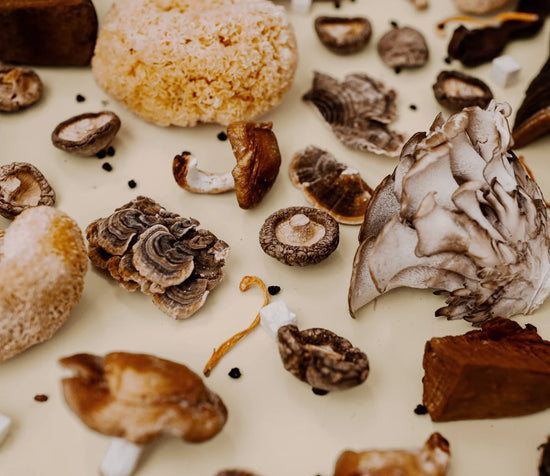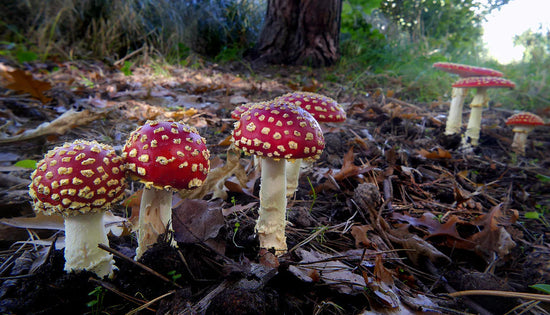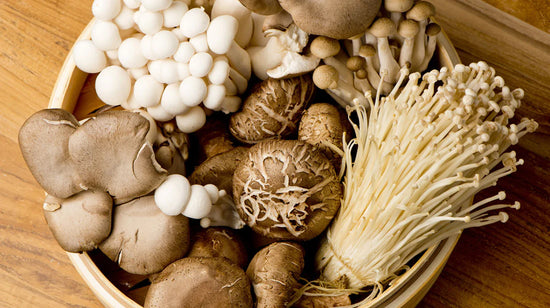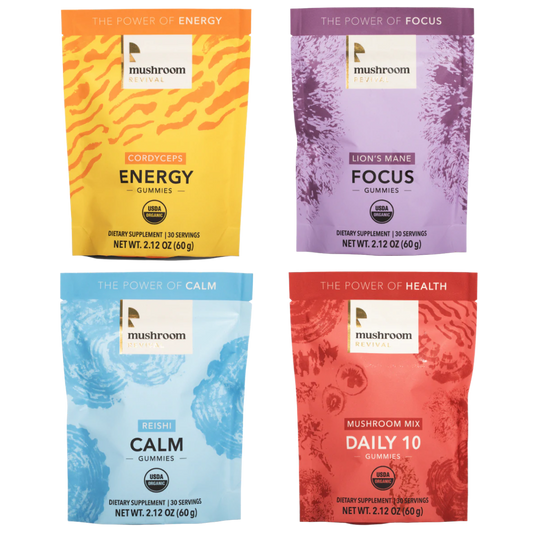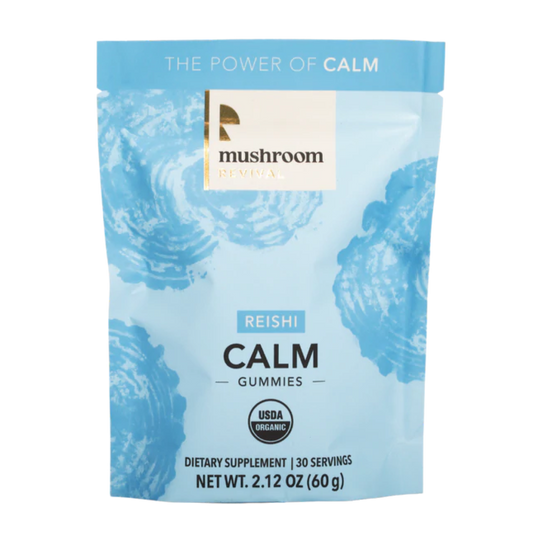The Lesser-Known Species of Wild Mushrooms You Need to Discover
Alex Dorr
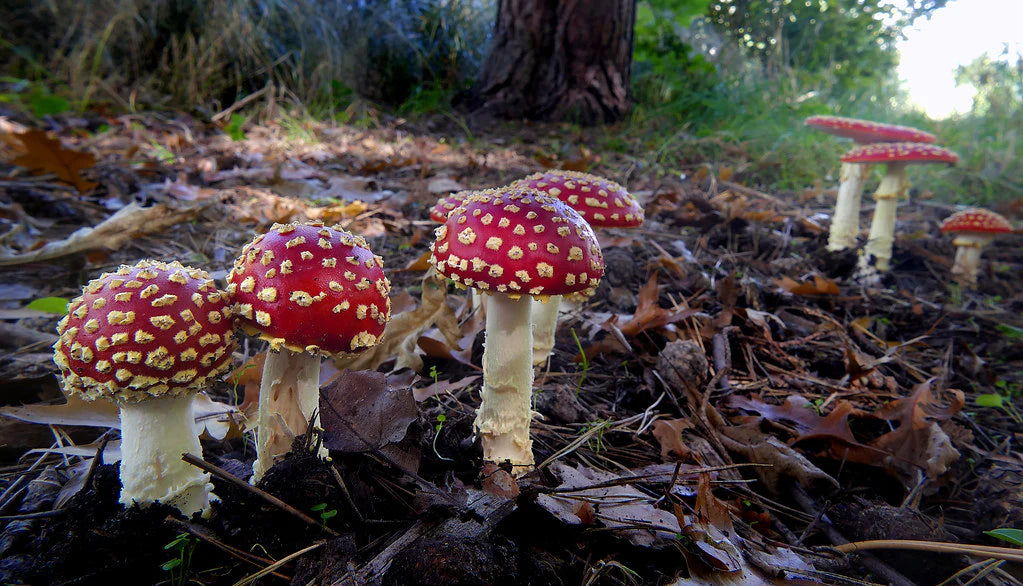
A Hidden Gem in the Autumn Forest
Imagine a crisp autumn day. The air is cool and carries the scent of damp earth and fallen leaves. As you crunch through the colorful carpet beneath a towering oak, your eyes scan the base for the familiar thin, fan shape of an oyster mushroom. . But this time, something unexpected catches your attention. Nestled amongst the decaying leaves lies a cluster of feathery, brownish-grey structures unlike anything you've ever seen. Curiosity piqued, you kneel down for a closer look. You ask yourself, “Is that a maitake mushroom?“
A Universe Beyond the Button Mushroom
The world of wild mushrooms is a vast and fascinating one for mushroom hunters. Estimates suggest there could be as many as 10 million species, yet most people only encounter a handful of common varieties. Most people are familiar with the common mushroom like white button, cremini, and the portobello - which are actually the same species (Agaricus bisporus) at different stages of maturity! The white button mushroom is the young version, with a closed or slightly opened cap. As it matures, the cap expands and turns brown, eventually becoming the large, open-capped portobello we know and love.
So, the next time you see a white button mushroom, imagine its hidden potential to transform into a hearty portobello! White button, portobello, oyster mushrooms, and chanterelle mushrooms dominate our grocery shelves. This narrow perspective leaves a whole universe of culinary and ecological wonders unexplored - the wild world of edible wild mushrooms.
Why Explore Lesser-Known Edible Mushrooms?
Venturing beyond the familiar offers a multitude of benefits. For adventurous mushroom hunters, lesser-known edible mushrooms offer a chance to discover a kaleidoscope of unique flavors and textures. The aptly named "Chicken of the Woods" boasts a meaty, umami richness, while the "Shaggy Mane" has a delicate, nutty taste best enjoyed young.
Beyond the culinary adventure, foraging for wild mushrooms promotes environmental responsibility. It allows you to harvest sustainable and delicious mushrooms as a food source. F you can’t make it to the forest, try to find commercially grown mushrooms whose growing techniques follow sustainable practices, like us here at Mushroom Revival!
Perhaps the most profound benefit lies in the connection it fosters with nature. Learning to identify and appreciate these fascinating organisms requires keen observation and respect for the delicate balance of the forest ecosystem. Each foray becomes a treasure hunt, a chance to witness the hidden wonders that lie beneath the surface, and a reminder of the intricate web of life that sustains us all.
Safety First: A Golden Rule
Before venturing into this exciting world of edible mushrooms, a word of caution is essential. With so many varieties – some incredibly delicious, others lethally poisonous – proper identification is paramount. There's no substitute for in-depth knowledge. Invest in reliable field guides and consult reputable online resources to learn the key characteristics of edible species and their poisonous mushroom look-alikes. Remember, there's no single "magic trick" for identifying wild mushrooms. It requires a combination of observation skills, knowledge of key features, and a healthy dose of respect for the power these organisms. For an in-depth look at 75 of the most fascinating mushrooms in the world, check out this beuatifully illustrated guide written by our founder, Alex Dorr, The Little Book of Mushrooms. With this foundation of awareness and a sense of adventure, you're ready to embark on a journey into the captivating world of lesser-known wild, edible mushrooms.
Lesser-Known Edible Mushrooms
This section dives into the exciting world of lesser-known edible mushrooms, exploring some of the easiest mushrooms to identify. Remember, proper identification is crucial before consuming any wild mushroom. Consult reliable field guides and online resources to learn key characteristics to avoid poisonous mushrooms.
Forest Floor Treasures:
1. Maitake mushrooms (Hen of the Woods mushrooms)
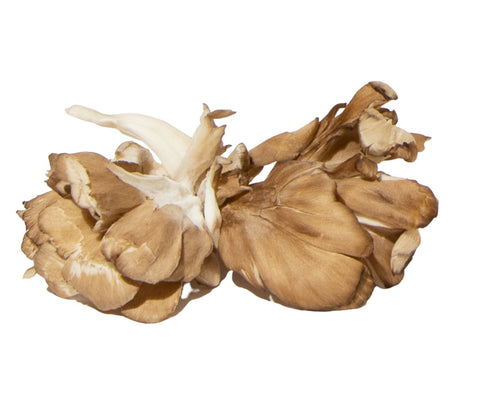
-
Description: This prized mushroom boasts a unique appearance. It forms clusters of feathery "fronds" with light brown to tan coloring, resembling a hen with its plumage. The individual fronds are typically 1-3 inches long and can be quite dense.
-
Identification Tips: Look for the distinctive feathery clusters. The color can vary from light brown to tan, with some specimens having a slightly greyish hue.
-
Flavor Profile: Hen of the Woods is known for its meaty texture and rich, earthy flavor with umami notes. It's a versatile culinary delight, perfect for sautéing, grilling, or using in soups and stews.
-
Nutritional Benefits: Hen of the Woods is a good source of vitamins, minerals, and antioxidants. It contains vitamins C, D, B complex vitamins, potassium, and fiber.
2. Black Trumpet mushrooms (Craterellus fallax):
-
Description: This elegant mushroom lives up to its name. It features a trumpet-like fruiting body with a hollow interior. The color ranges from blackish-brown to dark grey, and the texture is smooth.
-
Identification Tips: The key identifier is the hollow, trumpet-shaped fruiting body with a distinctive black or dark grey color. Avoid any mushrooms with gills or a different shape.
-
Flavor Profile: Black Trumpet offers an earthy, peppery flavor with a hint of smoke. It adds depth and complexity to sauces, soups, and pasta dishes.
-
Nutritional Benefits: Black Trumpet is a good source of dietary fiber and vitamin D. It also contains some potassium and iron.
Edible Mushrooms Found on Dead wood:
1. Chicken of the Woods Mushrooms (Laetiporus sulphureus):
Description: Unlike its close relative the Hen of the Woods, Chicken of the Woods mushrooms boast vibrant colors. They grow in shelf-like clusters on trees, with bright orange, yellow-orange, or red-orange caps that often have a wavy yellow margin.
Identification Tips: Look for the bracket-like shelves with wavy or lobed caps. The bright orange, yellow, or red coloring is a key distinguishing feature of Chicken of the Woods.
Flavor Profile: Chicken of the Woods mushrooms are prized for their meaty texture and savory, chicken-like flavor.
Nutritional Benefits: Like Maitake mushrooms, Chicken of the Woods offer vitamins, minerals, and antioxidants.
2. Lion's Mane mushroom (Hericium erinaceus):

Description: This visually striking mushroom has a unique cascading structure. Long, white "teeth" or "icicles" hang from a central stalk, resembling a lion's mane. The texture is slightly spiny.
Identification Tips: The unique cascading structure with white color and slightly spiny texture sets Lion's Mane mushrooms apart from others.
Flavor Profile: Lion's Mane mushrooms offer a delicate, crab-like flavor with a slightly sweet aftertaste. They are best suited for sautéing, grilling, or using in soups and stews to enjoy its unique texture.
Nutritional Benefits: Lion's mane mushrooms have a reputation for supporting cognitive function and healthy energy levels.
Fields and Meadows:
1. Shaggy Mane (Coprinus comatus):
Description: This mushroom undergoes a fascinating transformation. Initially, it appears egg-shaped with a shaggy white cap, resembling a miniature, fuzzy pear. As it matures, the cap flattens and breaks apart, revealing the shaggy white "scales" on its surface. The cap color darkens to a grayish-brown, and the gills underneath liquefy into an inky black liquid.
Identification Tips: Look for the unique egg-shaped to shaggy-capped appearance in its early stages. The shaggy white scales on the cap and the inky black liquid dissolving the gills in mature specimens are clear giveaways. Avoid any mushrooms with smooth caps or brightly colored gills, as these could be poisonous look alikes.
Flavor Profile: Shaggy Mane is best enjoyed young when it has a delicate, mushroomy flavor with a slightly nutty taste. Some describe it as having a hint of sweetness. The texture is tender and slightly meaty. Do not consume the inky black liquid stage, as it has a foul taste and may cause digestive upset.
Nutritional Benefits: Shaggy Mane is a good source of protein and dietary fiber. It also contains some potassium, iron, and vitamins B1 and B2.
2. Chanterelle mushrooms (Cantharellus sp.):
Description: These vibrant edible mushrooms add a touch of sunshine to the mixed hardwood forests of the East Coast and Pacific Northwest. They feature funnel-shaped caps with wavy or in-folded edges. The cap color ranges from bright yellow to apricot orange, and the underside has false gills that run down the stem instead of true gills like many other mushrooms. These false gills are more like short ridges or wrinkles. The stem is typically lighter than the cap, smooth, and hollow.
Identification Tips: The key identifiers for Chanterelle are the funnel-shaped cap with wavy edges, bright yellow or orange color, and false gills that run down the stem. Avoid any mushrooms with true gills or caps in other colors, as these could be dangerous lookalikes. The apricot-like aroma is another helpful clue, although not all chanterelles have a strong scent.
Flavor Profile: Chanterelle is prized for its fruity, peppery flavor with a strong apricot aroma. It adds a touch of elegance to various dishes. The texture is meaty yet tender.
Nutritional Benefits: Chanterelle is a good source of vitamin A and potassium. It also contains some vitamin C, fiber, and copper.
3. Morel Mushrooms - Jewels of the Forest:
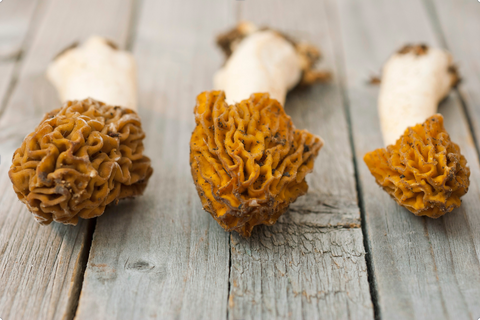
Description: Morel mushrooms (Morchella spp.) are a forager's prized possession. These captivating fungi resemble hidden treasures tucked amongst the forest debris, with their captivating honeycomb caps. Morels come in a variety of shapes and sizes, but all share a distinctive feature – a hollow body topped with a cap that resembles a honeycomb. Common varieties include the Black Morel (Morchella elata) with its dramatic dark tones, the Yellow Morel (Morchella esculenta) with its sunny hues, and the Blonde Morel (Morchella blonda) with its delicate coloring. Unlike true morels, which have a completely hollow interior from stem to cap, some poisonous mushrooms can mimic the honeycomb cap. This is why careful identification is crucial to avoid accidentally picking a dangerous lookalike.
Flavor Profile: Morel mushrooms boast a complex flavor profile, combining earthy, nutty, and slightly fruity notes with a satisfyingly meaty texture.
Nutritional Benefits: Morel mushrooms are a good source of vitamin D, offering a taste of the sun alongside their earthy, meaty flavor.
4. The Versatile Bolete Bunch (Boletus spp.)
Description: Bolete mushrooms, a diverse group with the genus Boletus at its heart, are a forager's delight. These fungi come in a variety of shapes, sizes, and colors, but they all share one key characteristic – a spongy underside instead of the familiar gills found on many mushrooms. The most prized member of the Bolete family is undoubtedly the Porcini (Boletus edulis), boasting a rich, nutty flavor and meaty texture that elevates countless dishes. But the wonders of boletes extend far beyond this culinary star. King Bolete (Boletus edulis var. grandedulis) is another favorite, especially in North America, known for its massive size and impressive presence. From the reddish-brown caps of the Bay Bolete (Boletus badius) to the dark, almost black, beauty of the Aereus Bolete (Boletus aereus), there's a bolete waiting to be discovered in your local forests.
Identification Tips: Know Your Bolete
While many boletes are edible delicacies, some have poisonous lookalikes. Here are some key identification tips to remember:
-
Spongy Pores: Unlike gilled mushrooms, boletes have a spongy pore surface underneath the cap. These pores are tiny tubes that release spores for reproduction.
-
Net-Like Pattern: Many boletes, including the Porcini, have a net-like pattern (reticulation) on the upper part of the stem. This can be a helpful identifier, but not all boletes have it.
-
Color and Size: Bolete colors range from brown and red to yellow and white, and their sizes can vary greatly. Consult reliable field guides to learn about the specific boletes in your area.
-
When in Doubt, Leave it Out: Safety is paramount. If you cannot confidently identify a bolete, always err on the side of caution and leave it behind.
Flavor and Culinary Uses: A Fungus for All Seasons
The culinary magic of boletes lies in their versatility. Porcini mushrooms are known for their rich, earthy flavor, while other boletes offer a range of taste profiles, from slightly sweet to nutty. Their meaty texture makes them perfect for sauteing, grilling, or adding depth to stews and soups. Whether you're a seasoned chef or a curious beginner, the world of bolete mushrooms offers a delicious adventure waiting to be explored.
Other Interesting Varieties:
The world of edible wild mushrooms extends far beyond the common button mushrooms found at grocery stores. Here are a few more examples to pique your curiosity:.
-
Lobster Mushroom: Lobster mushrooms (Hypomyces lactifluorum) aren't actually mushrooms, but a parasitic mold that takes over other mushrooms like Lactarius or Russula. This colorful fungus turns the host mushroom a bright reddish-orange, resembling cooked lobster meat. These bumpy, oddly shaped fungi are found in the wild during fall, mostly in New England and the West Coast of North America, under various trees.
-
Witches' butter mushrooms: also known as Tremella mesenterica, are jelly-like, brain-shaped fungus that adds a surprising bounce to forest walks. While not recommended for eating, Witches butter unique texture and vibrant colors make it a fascinating forest find.
-
Giant puffball mushrooms (Calvatia gigantea): are enormous, white fungi found in meadows and forests worldwide. They resemble giant puffballs of cotton candy and have a mild, earthy flavor that absorbs the tastes around them when cooked.
Unveiling Nature's Hidden Treasures: Functional Fungi
Ancient Practices, Modern Discoveries
In our exploration of lesser-known edible wild mushrooms, we'd be remiss not to mention a fascinating category: functional fungi, also known as adaptogenic mushrooms For millennia, various cultures around the world have incorporated mushrooms into their traditional healing practices. Modern scientific research is now beginning to explore the potential benefits of these fascinating fungi.
-
Lion's Mane (Hericium erinaceus): This visually striking mushroom features cascading white "teeth" or "icicles" that hang from a central stalk. It's typically found on dead hardwood trees like oak, beech, and maple. Traditionally, Lion's Mane has been used to support cognitive function and overall well-being.
-
Reishi (Ganoderma lucidum): Often described as kidney-shaped with a lacquered, shiny surface, Reishi comes in various reddish-brown to deep brown colors. Look for it growing on the trunks or at the base of dead hardwood trees. Traditionally, Reishi has been used to support overall well-being and immune function.
-
Chaga (Inonotus obliquus): This unique mushroom has a black, charcoal-like appearance and often encrusts birch trees. It can be difficult to spot due to its dark color blending with the bark. Traditionally, Chaga has been used to support the immune system.
-
Turkey Tail (Trametes versicolor): Easily recognizable by its fan-shaped clusters, Turkey Tail boasts a beautiful display of multicolored bands – brown, grey, and white – on its cap. It's commonly found on dead logs and fallen branches of various hardwood trees. Traditionally, Turkey Tail has been used to support gut health.
-
Cordyceps (Cordyceps militaris): Unlike the previous examples, Cordyceps is a parasitic fungus that grows on the bodies of insects. Due to its rarity and harvesting difficulty, Cordyceps is not typically foraged, but can be cultivated. Traditionally, Cordyceps has been used to support energy levels and stamina.
-
Maitake (Grifola frondosa): Maitake has a feathery appearance and has been studied for its support for the immune system and healthy blood sugar response.
The Safe and Convenient Option: Ethically Sourced Products
While the allure of foraging for these edible wild mushrooms is understandable, prioritizing safety is paramount. Mushroom identification requires significant expertise, and even slight mistakes can have serious consequences.
Thankfully, there's a safe and convenient alternative! Mushroom Revival offers a variety of ethically sourced and organic functional mushroom products in the form of powders, capsules, tinctures, and gummies. We are passionate about sustainable harvesting practices, allowing you to explore the world of functional mushrooms with peace of mind.
Responsible Foraging: A Sustainable Adventure
Venturing into the woods to forage for wild mushrooms can be an exciting adventure. However, with this exploration comes the responsibility to ensure the continued health of these delicate ecosystems. Here are some key principles for responsible foraging:
Leave No Trace:
The philosophy of "Leave No Trace" extends to the world of mushroom foraging. Minimize your impact on the environment by staying on designated trails whenever possible. Avoid disturbing the natural habitat by moving logs or raking away leaf litter – these elements are crucial for the growth and health of mushrooms. When finished foraging, dispose of any waste properly and leave the forest floor as you found it.
Respecting the Land:
Mushrooms are the fruiting bodies of a vast network of underground fungal threads. When harvesting, it's important to be mindful of this interconnected system. Here's how to respect the land:
-
Target Mature Specimens: Only harvest mushrooms that are fully mature. Younger mushrooms are still developing and need time to disperse their spores, ensuring the continuation of the species.
-
Harvest Conservatively: Avoid taking everything you find. Leave some mushrooms behind, especially larger, mature ones, so they can release their spores and contribute to the long-term health of the population.
-
Use Proper Tools: Carry a basket with breathable mesh or wicker to allow spores to disperse as you walk. Avoid plastic bags, which can trap moisture and damage the mushrooms.
Knowing Your Limits:
Foraging for wild mushrooms requires a healthy dose of caution. Here's how to prioritize safety:
-
Start Small: Begin by learning a few easily identifiable edible species and focus on harvesting small quantities.
-
Consult Reliable Resources: Invest in reputable field guides and online resources to learn proper identification techniques. There are many poisonous look-alikes, so never rely on a single source of information.
-
When in Doubt, Leave it Out: If there's any uncertainty about a mushroom's identity, err on the side of caution and leave it behind. Never consume a wild mushroom unless you are 100% confident in its identification.








